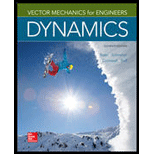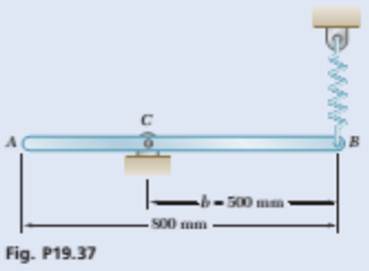
Vector Mechanics for Engineers: Dynamics
11th Edition
ISBN: 9780077687342
Author: Ferdinand P. Beer, E. Russell Johnston Jr., Phillip J. Cornwell, Brian Self
Publisher: McGraw-Hill Education
expand_more
expand_more
format_list_bulleted
Concept explainers
Textbook Question
Chapter 19.2, Problem 19.37P
The uniform rod shown has mass 6 kg and is attached to spring of constant

Expert Solution & Answer
Want to see the full answer?
Check out a sample textbook solution
Students have asked these similar questions
A cylinder and a disk are used as pulleys, as shown in the figure. Using the data
given in the figure, if a body of mass m = 3 kg is released from rest after falling a
height h 1.5 m, find:
a) The velocity of the body.
b) The angular velocity of the disk.
c) The number of revolutions the cylinder has made.
T₁
F
Rd =
0.2 m
md =
2 kg
T
T₂1
Rc = 0.4 m
mc = 5 kg
☐ m = 3 kg
(read image) (answer given)
11-5. Compute all the dimensional changes for the steel bar
when subjected to the loads shown. The proportional limit of the
steel is 230 MPa.
265 kN
100 mm
600 kN
25 mm thickness
X
Z
600 kN
450 mm
E=207×103 MPa; μ= 0.25
265 kN
Chapter 19 Solutions
Vector Mechanics for Engineers: Dynamics
Ch. 19.1 - A particle moves in simple harmonic motion....Ch. 19.1 - A particle moves in simple harmonic motion....Ch. 19.1 - Prob. 19.3PCh. 19.1 - Prob. 19.4PCh. 19.1 - Prob. 19.5PCh. 19.1 - Prob. 19.6PCh. 19.1 - A simple pendulum consisting of a bob attached to...Ch. 19.1 - A simple pendulum consisting of a bob attached to...Ch. 19.1 - A 10-Ib block A rests on a 40-Ib plate B that is...Ch. 19.1 - A 5-kg fragile glass vase is surrounded by packing...
Ch. 19.1 - Prob. 19.11PCh. 19.1 - Prob. 19.12PCh. 19.1 - Prob. 19.13PCh. 19.1 - Prob. 19.14PCh. 19.1 - Prob. 19.15PCh. 19.1 - Prob. 19.16PCh. 19.1 - Prob. 19.17PCh. 19.1 - Prob. 19.18PCh. 19.1 - Prob. 19.19PCh. 19.1 - Prob. 19.20PCh. 19.1 - A 50-kg block is supported by the spring...Ch. 19.1 - Prob. 19.22PCh. 19.1 - Two springs with constants k1and k2are connected...Ch. 19.1 - Prob. 19.24PCh. 19.1 - Prob. 19.25PCh. 19.1 - Prob. 19.26PCh. 19.1 - Prob. 19.27PCh. 19.1 - From mechanics of materials it is known that when...Ch. 19.1 - Prob. 19.29PCh. 19.1 - Prob. 19.30PCh. 19.1 - Prob. 19.31PCh. 19.1 - Prob. 19.32PCh. 19.1 - Prob. 19.33PCh. 19.1 - Prob. 19.34PCh. 19.1 - Using the data of Table 19.1, determine the period...Ch. 19.1 - Prob. 19.36PCh. 19.2 - The uniform rod shown has mass 6 kg and is...Ch. 19.2 - Prob. 19.38PCh. 19.2 - A 6-kg uniform cylinder can roll without sliding...Ch. 19.2 - A 6-kg uniform cylinder is assumed to roll without...Ch. 19.2 - Prob. 19.41PCh. 19.2 - Prob. 19.42PCh. 19.2 - A square plate of mass m is held by eight springs,...Ch. 19.2 - Prob. 19.44PCh. 19.2 - Prob. 19.45PCh. 19.2 - Prob. 19.46PCh. 19.2 - Prob. 19.47PCh. 19.2 - Prob. 19.48PCh. 19.2 - Prob. 19.49PCh. 19.2 - Prob. 19.50PCh. 19.2 - A thin homogeneous wire is bent into the shape of...Ch. 19.2 - A compound pendulum is defined as a rigid body...Ch. 19.2 - Prob. 19.53PCh. 19.2 - Prob. 19.54PCh. 19.2 - Prob. 19.55PCh. 19.2 - Two uniform rods each have a mass m and length I...Ch. 19.2 - Prob. 19.57PCh. 19.2 - A 1300-kg sports car has a center of gravity G...Ch. 19.2 - A 6-lb slender rod is suspended from a steel wire...Ch. 19.2 - A uniform disk of radius r=250 mm is attached at A...Ch. 19.2 - Prob. 19.61PCh. 19.2 - Prob. 19.62PCh. 19.2 - Prob. 19.63PCh. 19.2 - Prob. 19.64PCh. 19.2 - A 5-kg uniform rod CD of length l=0.7 m is welded...Ch. 19.2 - A uniform equilateral triangular plate with a side...Ch. 19.2 - Prob. 19.67PCh. 19.2 - Prob. 19.68PCh. 19.3 - Prob. 19.69PCh. 19.3 - Prob. 19.70PCh. 19.3 - Prob. 19.71PCh. 19.3 - Prob. 19.72PCh. 19.3 - Prob. 19.73PCh. 19.3 - Prob. 19.74PCh. 19.3 - Prob. 19.75PCh. 19.3 - A homogeneous wire of length 2l is bent as shown...Ch. 19.3 - A uniform disk of radius r and mass m can roll...Ch. 19.3 - Prob. 19.78PCh. 19.3 - Prob. 19.79PCh. 19.3 - Prob. 19.80PCh. 19.3 - A slender 10-kg bar AB with a length of l=0.6 m is...Ch. 19.3 - Prob. 19.82PCh. 19.3 - Prob. 19.83PCh. 19.3 - Prob. 19.84PCh. 19.3 - Prob. 19.85PCh. 19.3 - Prob. 19.86PCh. 19.3 - Prob. 19.87PCh. 19.3 - Prob. 19.88PCh. 19.3 - Prob. 19.89PCh. 19.3 - Prob. 19.90PCh. 19.3 - Prob. 19.91PCh. 19.3 - Prob. 19.92PCh. 19.3 - The motion of the uniform rod AB is guided by the...Ch. 19.3 - Prob. 19.94PCh. 19.3 - Prob. 19.95PCh. 19.3 - Prob. 19.96PCh. 19.3 - Prob. 19.97PCh. 19.3 - Prob. 19.98PCh. 19.4 - Prob. 19.99PCh. 19.4 - Prob. 19.100PCh. 19.4 - Prob. 19.101PCh. 19.4 - Prob. 19.102PCh. 19.4 - Prob. 19.103PCh. 19.4 - Prob. 19.104PCh. 19.4 - Prob. 19.105PCh. 19.4 - Prob. 19.106PCh. 19.4 - Prob. 19.107PCh. 19.4 - The crude-oil pumping rig shown is driven at 20...Ch. 19.4 - Prob. 19.109PCh. 19.4 - Prob. 19.110PCh. 19.4 - Prob. 19.111PCh. 19.4 - Prob. 19.112PCh. 19.4 - Prob. 19.113PCh. 19.4 - Prob. 19.114PCh. 19.4 - Prob. 19.115PCh. 19.4 - Prob. 19.116PCh. 19.4 - Prob. 19.117PCh. 19.4 - Prob. 19.118PCh. 19.4 - Prob. 19.119PCh. 19.4 - Prob. 19.120PCh. 19.4 - Prob. 19.121PCh. 19.4 - Prob. 19.122PCh. 19.4 - Prob. 19.123PCh. 19.4 - Prob. 19.124PCh. 19.4 - Prob. 19.125PCh. 19.4 - A small trailer and its load have a total mass of...Ch. 19.5 - Prob. 19.127PCh. 19.5 - Prob. 19.128PCh. 19.5 - Prob. 19.129PCh. 19.5 - Prob. 19.130PCh. 19.5 - Prob. 19.131PCh. 19.5 - Prob. 19.132PCh. 19.5 - Prob. 19.133PCh. 19.5 - Prob. 19.134PCh. 19.5 - Prob. 19.135PCh. 19.5 - Prob. 19.136PCh. 19.5 - Prob. 19.137PCh. 19.5 - A 0.9-kg block B is connected by a cord to a...Ch. 19.5 - Prob. 19.139PCh. 19.5 - Prob. 19.140PCh. 19.5 - Prob. 19.141PCh. 19.5 - Prob. 19.142PCh. 19.5 - Prob. 19.143PCh. 19.5 - Prob. 19.144PCh. 19.5 - Prob. 19.145PCh. 19.5 - Prob. 19.146PCh. 19.5 - Prob. 19.147PCh. 19.5 - Prob. 19.148PCh. 19.5 - A simplified model of a washing machine is shown....Ch. 19.5 - Prob. 19.150PCh. 19.5 - Prob. 19.151PCh. 19.5 - Prob. 19.152PCh. 19.5 - Prob. 19.153PCh. 19.5 - Prob. 19.154PCh. 19.5 - Prob. 19.155PCh. 19.5 - Prob. 19.156PCh. 19.5 - Write the differential equations defining (a) the...Ch. 19.5 - Write the differential equations defining (a) the...Ch. 19 - Prob. 19.159RPCh. 19 - Prob. 19.160RPCh. 19 - Prob. 19.161RPCh. 19 - Prob. 19.162RPCh. 19 - Prob. 19.163RPCh. 19 - Prob. 19.164RPCh. 19 - A 4-lb uniform rod is supported by a pin at O and...Ch. 19 - Prob. 19.166RPCh. 19 - Prob. 19.167RPCh. 19 - Prob. 19.168RPCh. 19 - Prob. 19.169RPCh. 19 - Prob. 19.170RP
Additional Engineering Textbook Solutions
Find more solutions based on key concepts
What output will the following lines of code display on the screen? cout "The works of Wolfgang\ninclude the f...
Starting Out with C++: Early Objects (9th Edition)
CONCEPT QUESTIONS
15.CQ3 The ball rolls without slipping on the fixed surface as shown. What is the direction ...
Vector Mechanics for Engineers: Statics and Dynamics
How is the hydrodynamic entry length defined for flow in a pipe? Is the entry length longer in laminar or turbu...
Fluid Mechanics: Fundamentals and Applications
1.2 Explain the difference between geodetic and plane
surveys,
Elementary Surveying: An Introduction To Geomatics (15th Edition)
What is an uninitialized variable?
Starting Out with Programming Logic and Design (5th Edition) (What's New in Computer Science)
What types of coolant are used in vehicles?
Automotive Technology: Principles, Diagnosis, And Service (6th Edition) (halderman Automotive Series)
Knowledge Booster
Learn more about
Need a deep-dive on the concept behind this application? Look no further. Learn more about this topic, mechanical-engineering and related others by exploring similar questions and additional content below.Similar questions
- T₁ F Rd = 0.2 m md = 2 kg T₂ Tz1 Rc = 0.4 m mc = 5 kg m = 3 kgarrow_forward2. Find a basis of solutions by the Frobenius method. Try to identify the series as expansions of known functions. (x + 2)²y" + (x + 2)y' - y = 0 ; Hint: Let: z = x+2arrow_forward1. Find a power series solution in powers of x. y" - y' + x²y = 0arrow_forward
- 3. Find a basis of solutions by the Frobenius method. Try to identify the series as expansions of known functions. 8x2y" +10xy' + (x 1)y = 0 -arrow_forwardHello I was going over the solution for this probem and I'm a bit confused on the last part. Can you please explain to me 1^4 was used for the Co of the tubular cross section? Thank you!arrow_forwardBlood (HD = 0.45 in large diameter tubes) is forced through hollow fiber tubes that are 20 µm in diameter.Equating the volumetric flowrate expressions from (1) assuming marginal zone theory and (2) using an apparentviscosity for the blood, estimate the marginal zone thickness at this diameter. The viscosity of plasma is 1.2 cParrow_forward
- Q2: Find the shear load on bolt A for the connection shown in Figure 2. Dimensions are in mm Fig. 2 24 0-0 0-0 A 180kN (10 Markarrow_forwarddetermine the direction and magnitude of angular velocity ω3 of link CD in the four-bar linkage using the relative velocity graphical methodarrow_forwardFour-bar linkage mechanism, AB=40mm, BC=60mm, CD=70mm, AD=80mm, =60°, w1=10rad/s. Determine the direction and magnitude of w3 using relative motion graphical method. A B 2 3 77777 477777arrow_forward
- Four-bar linkage mechanism, AB=40mm, BC=60mm, CD=70mm, AD=80mm, =60°, w1=10rad/s. Determine the direction and magnitude of w3 using relative motion graphical method. A B 2 3 77777 477777arrow_forwardThe evaporator of a vapor compression refrigeration cycle utilizing R-123 as the refrigerant isbeing used to chill water. The evaporator is a shell and tube heat exchanger with the water flowingthrough the tubes. The water enters the heat exchanger at a temperature of 54°F. The approachtemperature difference of the evaporator is 3°R. The evaporating pressure of the refrigeration cycleis 4.8 psia and the condensing pressure is 75 psia. The refrigerant is flowing through the cycle witha flow rate of 18,000 lbm/hr. The R-123 leaves the evaporator as a saturated vapor and leaves thecondenser as a saturated liquid. Determine the following:a. The outlet temperature of the chilled waterb. The volumetric flow rate of the chilled water (gpm)c. The UA product of the evaporator (Btu/h-°F)d. The heat transfer rate between the refrigerant and the water (tons)arrow_forward(Read image) (Answer given)arrow_forward
arrow_back_ios
SEE MORE QUESTIONS
arrow_forward_ios
Recommended textbooks for you
 Elements Of ElectromagneticsMechanical EngineeringISBN:9780190698614Author:Sadiku, Matthew N. O.Publisher:Oxford University Press
Elements Of ElectromagneticsMechanical EngineeringISBN:9780190698614Author:Sadiku, Matthew N. O.Publisher:Oxford University Press Mechanics of Materials (10th Edition)Mechanical EngineeringISBN:9780134319650Author:Russell C. HibbelerPublisher:PEARSON
Mechanics of Materials (10th Edition)Mechanical EngineeringISBN:9780134319650Author:Russell C. HibbelerPublisher:PEARSON Thermodynamics: An Engineering ApproachMechanical EngineeringISBN:9781259822674Author:Yunus A. Cengel Dr., Michael A. BolesPublisher:McGraw-Hill Education
Thermodynamics: An Engineering ApproachMechanical EngineeringISBN:9781259822674Author:Yunus A. Cengel Dr., Michael A. BolesPublisher:McGraw-Hill Education Control Systems EngineeringMechanical EngineeringISBN:9781118170519Author:Norman S. NisePublisher:WILEY
Control Systems EngineeringMechanical EngineeringISBN:9781118170519Author:Norman S. NisePublisher:WILEY Mechanics of Materials (MindTap Course List)Mechanical EngineeringISBN:9781337093347Author:Barry J. Goodno, James M. GerePublisher:Cengage Learning
Mechanics of Materials (MindTap Course List)Mechanical EngineeringISBN:9781337093347Author:Barry J. Goodno, James M. GerePublisher:Cengage Learning Engineering Mechanics: StaticsMechanical EngineeringISBN:9781118807330Author:James L. Meriam, L. G. Kraige, J. N. BoltonPublisher:WILEY
Engineering Mechanics: StaticsMechanical EngineeringISBN:9781118807330Author:James L. Meriam, L. G. Kraige, J. N. BoltonPublisher:WILEY

Elements Of Electromagnetics
Mechanical Engineering
ISBN:9780190698614
Author:Sadiku, Matthew N. O.
Publisher:Oxford University Press

Mechanics of Materials (10th Edition)
Mechanical Engineering
ISBN:9780134319650
Author:Russell C. Hibbeler
Publisher:PEARSON

Thermodynamics: An Engineering Approach
Mechanical Engineering
ISBN:9781259822674
Author:Yunus A. Cengel Dr., Michael A. Boles
Publisher:McGraw-Hill Education

Control Systems Engineering
Mechanical Engineering
ISBN:9781118170519
Author:Norman S. Nise
Publisher:WILEY

Mechanics of Materials (MindTap Course List)
Mechanical Engineering
ISBN:9781337093347
Author:Barry J. Goodno, James M. Gere
Publisher:Cengage Learning

Engineering Mechanics: Statics
Mechanical Engineering
ISBN:9781118807330
Author:James L. Meriam, L. G. Kraige, J. N. Bolton
Publisher:WILEY
Introduction to Undamped Free Vibration of SDOF (1/2) - Structural Dynamics; Author: structurefree;https://www.youtube.com/watch?v=BkgzEdDlU78;License: Standard Youtube License